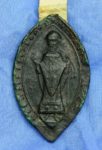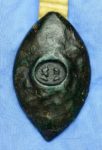
Charter of Henry of Blois, c. 1140 [WCM 10629]
c. 1140
Manuscript on parchment with wax seal (the document 17 x 15 cm; the seal 9 x 5.5 cm)
This is one of four charters issued by Henry of Blois in the College archives. It dates from Henry’s long tenure as Bishop of Winchester, from 1129 to 1171. The document confirms a grant of one hide of land called ‘Hamela’ to Hamble Priory, which had been founded by Henry’s predecessor, William Giffard (1100-28). In 1391, William of Wykeham purchased the priory of Hamble for his College in Winchester. With the lands of the priory came numerous deeds and charters recording their ownership.
Attached to the charter is the personal seal that Henry devised for himself as Bishop of Winchester and papal legate. It shows Henry as bishop, with his right hand raised in benediction and his left holding a pastoral staff. The legend surrounding the figure on the obverse of the seal reads ‘+HENRICUS DEI GRATIA WINTONIENSIS EPISCOPUS’ – Henry by the grace of God, bishop of Winchester. On the reverse, a Roman intaglio has been used as a counterseal.
It is thought that the earliest surviving impression of Henry’s episcopal seal is attached to a letter sent by Henry to Pope Eugenius III between 1145-8, but this example may well be slightly earlier. In the portrait on the obverse, Henry wears the pallium, which he was entitled to as papal legate, an office he held from 1139-43. The list of witnesses suggests it was issued before 1140.
Henry of Blois is well known as a patron of the arts. He rebuilt Wolvesey Palace in Winchester and the nearby Hospital of St Cross. He commissioned a famous psalter now in the British Library, as well as the Winchester Bible still at the Cathedral. Henry’s choice of counterseal was consistent with his artistic patronage and interest in Classical art. The use of an ancient gem as a counterseal was fashionable in the 1140s, but they were often reinterpreted, with surrounding inscriptions showing how the pagan images had been given Christian significance. Henry’s gem shows Zeus Sarapis wearing the distinctive modius headdress and facing the goddess Isis, and was probably made in the eastern Mediterranean. It is possible Henry picked it up during one of his visits to Rome. He may have noticed the resemblance to papal bulls, which had an image of the confronted heads of SS. Peter and Paul, communicating papal authority and the concordia apostolorum. If so, it may have evoked Winchester as well as Cluny, where Henry was brought up, since both were dedicated to Peter and Paul.
The choices open to seal-cutters in the twelfth century were few, since the prescribed form was necessarily conservative: it was important the seal looked like an episcopal seal. This meant even subtle adjustments in the form were potentially significant. Henry’s appearance on his personal seal resembles the famous image of him in the Winchester Bible, where he is found playing the part of Pope Desiderius. It also reminds us of John of Salisbury’s Historia Pontificalis, in which John pokes fun at Henry’s ‘long beard and philosophical solemnity’. To contemporaries, however, the seal conferred Henry’s authority as bishop of Winchester. Its symbolism and counterseal suggest his deep religious sensibility and interest in ideas.
Literature: Jeffrey West, ‘A Taste for the Antique? Henry of Blois and the Arts’, in C. P. Lewis (ed.), Anglo-Norman Studies XXX: Proceedings of the Battle Conference 2007 (Woodbridge, 2008), pp. 226-28; Martin Henig, ‘The Re-Use and Copying of Ancient Intaglios set in Medieval Personal Seals, mainly found in England: an aspect of the Renaissance of the 12th Century’ in Nöel Adams, John Cherry and James Robinson (eds.), Good Impressions: image and authority in medieval seals (London, 2008), p. 29; Caroline Simonet, ‘The (Re-)Use of Ancient Gems and Coins: the Presence of Antiquity in Medieval Sigillography’, in Laura Whatley (ed), A Companion to Seals in the Middle Ages (Leiden, 2019), p. 373
Provenance: Acquired with the priory of Hamble in 1391
Locations: College Archives



